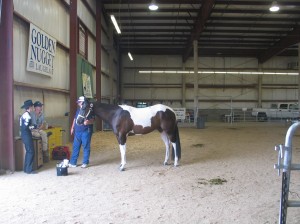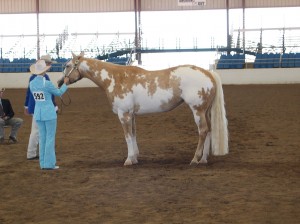The name comes from the Spanish word pintado. Translated, this means painted, or in cowboy language, paint. Spotted horses and/or partially colored horses were also called calicos.This breed’s history, foundation and development most probably was identical to the American Quarter Horse with one distinguishable exception: Color. It is therefore no surprise that The American Paint Horse Association was thought to be formed primarily because The American Quarter Horse Association does not register horses with white body markings (for the specific regulations on color see the AQHA official handbook of rules and regulations for 2002).It’s easy to understand why this is the second most popular breed in the US. Here’s the recipe: Take a Quarter horse, add color and you get a Paint. For many, this is the most beautiful horse in the world.
History.
In the 16th century, Spanish explorers sailed for the new continent and brought their horses with them. Among these horses were Spotted War horses. According to one historian, one of those horses was white and sorrel with spots on its belly. It is believed that this horse bred with American Mustangs thereby creating the foundation of the American Paint Horse breed of today.
By the early 19th century The Spotted Horse, as it was called, became popular particularly among the American Indians. Commanches had many spotted horses in their herds. In August of 1962, The American Paint Stock Horse Association was founded. By the end of the year it grew to 150 members with 250 registered horses.
About that same time a group of spotted horse lovers founded The American Paint Quarter Horse Association. These two groups merged into The American Paint Horse Association in 1965. In their very short history this breed has become the second most popular in The United States
Foundation.
Paint horses were from the same origin as Quarter horses, since other than their color, they would have been eligible for registration as American Quarter horses.
Type.
The Paint Horse Breed is considered to be one of the so-called stock-type horses. They are close coupled, balanced, muscular and built close to the ground. Substantial hindquarter and forearm muscles are required to produce the speed, power and athleticism necessary to the breed.
They are used for roping, cattle, pleasure, trial riding and any event requiring speed and athletic ability. Other breeds of this type include Quarter Horses and Appaloosas.
Colors.

Color is the main issue when it comes to this breed. In addition to color, registration requires the Paint Horse Sire and Dam (father & mother) be registered with The American Paint Horse Association, The Jockey Club (for Thoroughbreds), or The American Quarter Horse Association.
Although solid color horses are acceptable for registration, many are one of the following patterns:
1) Tobiano (pronounced: tow be yah’ no) The dark color usually covers one or both flanks. Generally, all four legs are white, at least below the hocks and knees. Generally, the spots are regular and distinct as ovals or round patterns that extend down over the neck and chest, giving the appearance of a shield. Head markings are like those of a solid-colored horse–solid, or with a blaze, strip, star or snip. A tobiano may be either predominantly dark or white. The tail is often two colors.
2) Overo (pronounced: oh vair’ oh) The white usually will not cross the back of the horse between its withers and its tail. Generally, at least one and often all four legs are dark. Generally, the white is irregular, and is rather scattered or splashy. Head markings are distinctive, often bald-faced, apron-faced or bonnet-faced. An overo may be either predominantly dark or white. The tail is usually one color.
3) Tovero (pronounced: tow vair’ oh) Dark pigmentation around the ears, which may expand to cover the forehead and/or eyes. One or both eyes blue. Dark pigmentation around the mouth, which may extend up the sides of the face and form spots. Chest spot(s) in varying sizes. These may also extend up the neck. Flank spot(s) ranging in size. These are often accompanied by smaller spots that extend forward across the barrel, and up over the loin. Spots, varying in size, at the base of the tail.
Horses eligible for the Regular Registry must have a minimum amount of white hair over unpigmented (pink) skin.






















